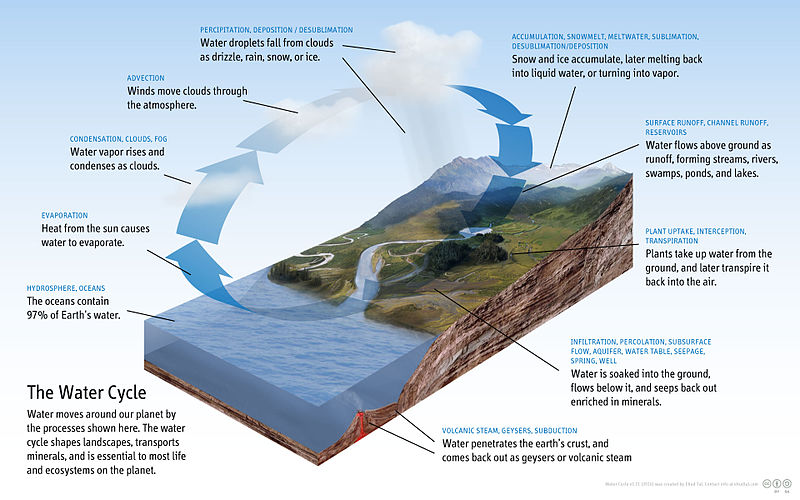Water cycle
|
This diagram of the water cycle shows how water is stored and transported across the planet. |
[edit] Introduction
The water cycle (or hydrological cycle) is a sequence of processes that drive the movement of the earth’s water, which is constantly transforming as it goes through different states of matter - from gaseous water vapour to liquid water and sometimes ice, and back again. The water cycle (sometimes referred to as the hydrologic cycle or the hydrological cycle) has no starting point or ending point, and the total amount of water within the cycle is essentially constant.
[edit] Characteristics of the water cycle
The Corps of Engineers - Portland District explains, “The global water cycle can be described with nine major physical processes which form a continuum of water movement. Complex pathways include the passage of water from the gaseous envelope around the planet called the atmosphere, through the bodies of water on the surface of earth such as the oceans, glaciers and lakes, and at the same time (or more slowly) passing through the soil and rock layers underground. Later, the water is returned to the atmosphere."
The nine primary physical processes of the water cycle are: evaporation, condensation, precipitation, interception, infiltration, percolation, transpiration, runoff and storage.
The water cycle is also involved in seven other processes related to geology and affiliated sciences: subduction and mineral hydration, snow melt, subsurface flow, sublimation, deposition, advection and plate tectonics.
Hydrology is concerned with the origin, distribution and properties of water on the globe and is one of the interdisciplinary sciences that is the basis for water resources development and water resources management.
NB Global Warming of 1.5 ºC, Glossary, published by the Intergovernmental Panel on Climate Change (IPCC) in 2018, defines the hydrological cycle as: ‘The cycle in which water evaporates from the oceans and the land surface, is carried over the earth in atmospheric circulation as water vapour, condenses to form clouds, precipitates as rain or snow, which on land can be intercepted by trees and vegetation, potentially accumulates as snow or ice, provides runoff on the land surface, infiltrates into soils, recharges groundwater, discharges into streams, flows out into the oceans, and ultimately evaporates again from the ocean or land surface. The various systems involved in the hydrological cycle are usually referred to as hydrological systems.’

|
| Watercycle installation at the Millennium Dome, 2000. Water from the roof of the Dome was collected and used to flush the toilets. Waste from the toilets was processed to generate electricity that was used to power the Dome. |
[edit] Related articles on Designing Buildings
Featured articles and news
RTPI leader to become new CIOB Chief Executive Officer
Dr Victoria Hills MRTPI, FICE to take over after Caroline Gumble’s departure.
Social and affordable housing, a long term plan for delivery
The “Delivering a Decade of Renewal for Social and Affordable Housing” strategy sets out future path.
A change to adoptive architecture
Effects of global weather warming on architectural detailing, material choice and human interaction.
The proposed publicly owned and backed subsidiary of Homes England, to facilitate new homes.
How big is the problem and what can we do to mitigate the effects?
Overheating guidance and tools for building designers
A number of cool guides to help with the heat.
The UK's Modern Industrial Strategy: A 10 year plan
Previous consultation criticism, current key elements and general support with some persisting reservations.
Building Safety Regulator reforms
New roles, new staff and a new fast track service pave the way for a single construction regulator.
Architectural Technologist CPDs and Communications
CIAT CPD… and how you can do it!
Cooling centres and cool spaces
Managing extreme heat in cities by directing the public to places for heat stress relief and water sources.
Winter gardens: A brief history and warm variations
Extending the season with glass in different forms and terms.
Restoring Great Yarmouth's Winter Gardens
Transforming one of the least sustainable constructions imaginable.
Construction Skills Mission Board launch sector drive
Newly formed government and industry collaboration set strategy for recruiting an additional 100,000 construction workers a year.
New Architects Code comes into effect in September 2025
ARB Architects Code of Conduct and Practice available with ongoing consultation regarding guidance.
Welsh Skills Body (Medr) launches ambitious plan
The new skills body brings together funding and regulation of tertiary education and research for the devolved nation.
Paul Gandy FCIOB announced as next CIOB President
Former Tilbury Douglas CEO takes helm.
UK Infrastructure: A 10 Year Strategy. In brief with reactions
With the National Infrastructure and Service Transformation Authority (NISTA).























